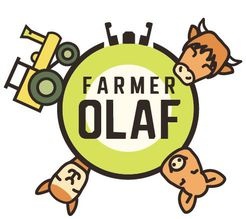After the fall of the greatest dwarven city, Arar, many years ago, almost all dwarves left the Valley of Three Passes. Now, Olaf's farm — the last one in the valley — has been struck by an earthquake. Dwarf Olaf sends for you, his grandchildren, to help him rebuild his farm and find his lost animals. He promises to reveal the biggest secret of the fallen city to the one who helps him the most.
Farmer Olaf is the first "no.table" family tabletop game (or so the publisher seems to think), which means it can be played comfortably on a big or small table — or on no table at all. The unique box design allows discarding and storing cards while holding it in one hand or being attached to a belt. Other advantages include starting or stopping game in seconds, quick save/quick load game ability, burst card dealing, quick independent release, and rules storage that doubles as a displayable cheat sheet. The maximum number of players is determined by game boxes used (with four additional players for each game box).
In Farmer Olaf, players perform four farming activities to gather green cards with points. The player with the most points at the end of the game wins. Farming activities include sowing and harvesting a field, milking a yak, making wool from alpaca, and making ham from a boar. Each player receives five cards at the start of the game and one card on each subsequent turn. Players try to collect appropriate cards for farming actions. For the most part, there is a shortage of buildings and animals needed for production. This means that in order to increase their chances of winning, a player needs to engage in trade with others. There are no limits of how to structure trades: from traditional 1-1 card exchange to more exotic deals like leasing or deferred payment. The game is carefully balanced as, for example, the best cards are steam machines that can be used only to sow and harvest a field. However, to do that one needs a fertilizer that can be obtained only by cleaning a boar pen or cowshed.
Simple rules and design (no text and no numbers on cards) allow children aged 5+ to participate in the game when playing with adults. The most demanding part is being a game master and managing cards in the box, thus the overall 10+ age rating.


